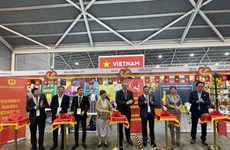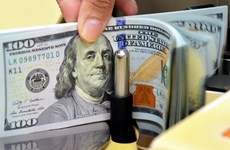Vietnam’s tourist sector wastes opportunities
Although tourism is one of the key economic sectors that bring in a
large amount of foreign currency to the country, each year, the lack of
unique organised tours means the sector is losing out on opportunities
to develop.
Although tourism is one of the key economic sectors that bring in a
large amount of foreign currency to the country, each year, the lack of
unique organised tours means the sector is losing out on opportunities
to develop.
According to the Vietnam National Administration of Tourism (VNAT), the tourism sector has developed well over the last few years, with international arrivals to the country reaching 3.8 million in 2009, a 15-fold increase compared to 1990 and peaking 4.3 million in 2008.
Last year, although the number of international visitors to Vietnam fell by 10 percent from the previous year, the amount of foreign currency directly earned from tourism still amounted to almost 4 billion USD, after garments, crude oil, footwear and seafood.
In the first months of 2010, when global tourism was still trying to weather the impact of the world’s economic crisis, many Asia-Pacific countries, including Vietnam , remained attractive to international tourists. With a growth rate of more than 30 percent over this period, the World Tourism Organisation ranked Vietnam fourth in tourism growth in the Asia-Pacific region, after Sri Lanka , Arab Saudi and Israel .
In the 2009 report on Travel & Tourism Competitiveness (TTC) announced by the World Economic Forum, Vietnam ranked 11 th out of 133 countries and territories for having competitive prices. This is why many people from overseas are attracted to Vietnam .
In addition, Vietnam has a lot of potential for developing its tourist industry and has also attracted a lot of foreign investors. In 2009 alone, FDI capital into the tourism sector reached 8.8 billion USD, accounting for 41 percent of the country’s total FDI that year.
Besides its material contributions to the national economy, the development of the sector has helped with the country’s economic restructuring, reduced poverty and generated jobs as well revitalised many traditional craft villages.
According to Vietnam ’s Human Resources Development Programme, the tourism sector annually creates millions of job opportunities for workers. During the 1991-2009 period, the amount of people working directly in the sector increased by nearly 20 times from 21,000 to 370,000.
Despite an average growth of close to 17 percent during the same period, a lack of competitiveness remains the largest obstacle for Vietnamese tourism, especially at a time when ASEAN nations are paying more attention to developing their own tourist industries, considering it a major factor for economic growth.
Among the ASEAN countries surveyed in the TTC report, minus Laos and Myanmar , Vietnam only ranks above Cambodia in tourism development. However, with its specific strategies and effective operations, Cambodia ’s tourism sector is becoming stronger and is likely to overtake Vietnam .
According to experts, low competitiveness comes from the fact that Vietnamese tourism does not concentrate on unique products and its services are simple and low quality. The sector does not have a overall development plan, which has resulted in a low rate of long-stay tourists.
In addition, not having a policy of refunding value added tax (VAT) for international tourists to encourage them to spend, as Thailand and Singapore have done, has also made Vietnamese tourism difficult to promote.
At a recent national seminar entitled “developing Vietnamese tourism in the context of international integration” in Hanoi , a number of measures were discussed with a focus on developing special tourism products, promotions and improving the country’s infrastructure and human resources.
The tourism sector has targeted welcoming 4.5 million international visitors in 2010, up 16 percent against last year./.
According to the Vietnam National Administration of Tourism (VNAT), the tourism sector has developed well over the last few years, with international arrivals to the country reaching 3.8 million in 2009, a 15-fold increase compared to 1990 and peaking 4.3 million in 2008.
Last year, although the number of international visitors to Vietnam fell by 10 percent from the previous year, the amount of foreign currency directly earned from tourism still amounted to almost 4 billion USD, after garments, crude oil, footwear and seafood.
In the first months of 2010, when global tourism was still trying to weather the impact of the world’s economic crisis, many Asia-Pacific countries, including Vietnam , remained attractive to international tourists. With a growth rate of more than 30 percent over this period, the World Tourism Organisation ranked Vietnam fourth in tourism growth in the Asia-Pacific region, after Sri Lanka , Arab Saudi and Israel .
In the 2009 report on Travel & Tourism Competitiveness (TTC) announced by the World Economic Forum, Vietnam ranked 11 th out of 133 countries and territories for having competitive prices. This is why many people from overseas are attracted to Vietnam .
In addition, Vietnam has a lot of potential for developing its tourist industry and has also attracted a lot of foreign investors. In 2009 alone, FDI capital into the tourism sector reached 8.8 billion USD, accounting for 41 percent of the country’s total FDI that year.
Besides its material contributions to the national economy, the development of the sector has helped with the country’s economic restructuring, reduced poverty and generated jobs as well revitalised many traditional craft villages.
According to Vietnam ’s Human Resources Development Programme, the tourism sector annually creates millions of job opportunities for workers. During the 1991-2009 period, the amount of people working directly in the sector increased by nearly 20 times from 21,000 to 370,000.
Despite an average growth of close to 17 percent during the same period, a lack of competitiveness remains the largest obstacle for Vietnamese tourism, especially at a time when ASEAN nations are paying more attention to developing their own tourist industries, considering it a major factor for economic growth.
Among the ASEAN countries surveyed in the TTC report, minus Laos and Myanmar , Vietnam only ranks above Cambodia in tourism development. However, with its specific strategies and effective operations, Cambodia ’s tourism sector is becoming stronger and is likely to overtake Vietnam .
According to experts, low competitiveness comes from the fact that Vietnamese tourism does not concentrate on unique products and its services are simple and low quality. The sector does not have a overall development plan, which has resulted in a low rate of long-stay tourists.
In addition, not having a policy of refunding value added tax (VAT) for international tourists to encourage them to spend, as Thailand and Singapore have done, has also made Vietnamese tourism difficult to promote.
At a recent national seminar entitled “developing Vietnamese tourism in the context of international integration” in Hanoi , a number of measures were discussed with a focus on developing special tourism products, promotions and improving the country’s infrastructure and human resources.
The tourism sector has targeted welcoming 4.5 million international visitors in 2010, up 16 percent against last year./.













